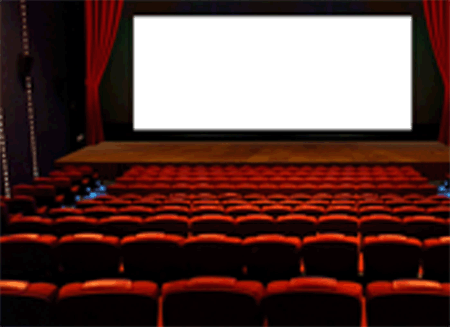Has the coronavirus killed movie theaters?
Movie going peaked in 1946 and has been on a long, slow decline ever since. That was before going to a theater meant you were risking your life. Center director Jeffrey Cole explores and eulogizes a once-great American experience.
By Jeffrey Cole
Going to the movies is just a memory from our old lives. It’s likely to stay that way.
Sitting in a crowded theater with a large screen may forever be replaced by streaming at home. Even if theaters do survive the pandemic, they will return slowly and for at least a year or so, maybe permanently, become a much smaller business.
 In the Center’s about-to-be released survey on the coronavirus pandemic, we ask Americans what activities they miss a lot while being sheltered in place. What we miss the most is “being able to go where I want and do what I please.” Coming in a close second is “visiting with friends and relatives I see regularly.”
In the Center’s about-to-be released survey on the coronavirus pandemic, we ask Americans what activities they miss a lot while being sheltered in place. What we miss the most is “being able to go where I want and do what I please.” Coming in a close second is “visiting with friends and relatives I see regularly.”
Next to bottom on a list of 15 activities people miss the most while stuck in their homes is going to the movies. The only thing we say we miss less is drinking and socializing in bars.
Moviegoing…going…gone? A long slow decline
Movie exhibition (going to theaters) has been in decline for over 70 years. In the 1930s 60% of the population went to the movies every week. Today people average one movie every three months.
Theater attendance reached its peak in 1946 when domestically (includes Canada) 4.3 billion movie tickets were sold. Since then the population has more than doubled. To keep pace with 1946 we would have to buy about 10 billion tickets a year: in 2019 we bought about 1.2 billion tickets.
What forever shrank movie attendance was the introduction of television in 1948. Most of us were happy to trade paying for tickets and the big screen for advertising on the little one. Add to that television meant better and less expensive food and the comfort of home.
Based on film admissions (the only apples-to-apples comparison) the 21st century theatrical film business is about 10-14% of what it had been in the 1940s. However, the business stabilized at around 1.2-1.4 billion tickets a year. The “lost” theater revenue was made up by sales to broadcast and cable, cassettes and DVDs, and more significantly in the past nine years, to streaming services such as Netflix.
By balancing the new sources of revenue coupled with what still remained of paid admissions and an increased growth of film outside the U.S., the movie business remained relatively viable. Until now.
The coronavirus pandemic has completely upset that balance, and will deeply and, we believe permanently, change the theater business. But that change was coming long before the virus. We have predicted a second significant downsizing of the theatrical business (after television in the 1940s) for a few years now.
When film’s main competitor was broadcast television, motion picture content could compete. Between 1948-2014 film in theaters meant bigger stories, bigger stars, and bigger screens. From the time Netflix began its first significant original “film” series, House of Cards, everything began to change.
House of Cards was an epic story of greed and ambition that could develop over many hours and starred double-Oscar winner Kevin Spacey as well as Emmy Award-winning Robin Wright and made by major film director David Fincher. While the theater still had a bigger screen, the average American television set sold beginning in 2016 was 55 inches or bigger in HD and now, for many, 4K.
___________________________________________________________________________
This is a major turning point in the history of film. It recognizes that the relationship between studios and exhibitors has been forever altered. Although cities may re-open soon, it will be a long time before we want to return to crowded theaters or concerts. Sports may have to re-appear by playing to empty arenas. But movies cannot play to empty theaters.
___________________________________________________________________________
Streaming was able to minimize the gap between the theater and home television. As Netflix became the overwhelmingly dominant streaming platform, its extraordinary growth gave it the budgets to spend $12 billion on production (last year). It created massive amounts of programming that the consumer got as part of a $12 a month subscription. Movie theaters could not compete.
If the story ended there, the future of the theatrical business was bleak but would decline over a 10-20 year period. Now everything is moving at hyper speed. There are two reasons.
Last November and December, Netflix premiered three Oscar-worthy films with huge stars that had barely been in the theater: The Irishman, Marriage Story, and The Two Popes. Although they had been in the theater for a very short window to qualify for Oscars, to the consumer it felt like they were on Netflix “Day-and-Date” — meaning the same day as the theater. Martin Scorsese intended The Irishman as a theatrical film, but no studio would finance it. It had a big story with big stars. As Netflix expected, they were Oscar-worthy and in early January the three films received 19 nominations.
This changes the theater vs. streaming equation. For $12 a month, a Netflix subscriber could get three big, Oscar-buzz films with major stars at what seemed like the same time they were in the theaters. How could the theaters possibly compete by charging $12-16 per person for a film?
Theatrical film would not die, we believed, but would be significantly downsized again because of the change in the value proposition. There are still a few films we wanted to see on the big screen with an audience (before the virus) for the social experience. We expected to see theatrical admissions fall over the next 10-15 years to 500 million tickets a year and for half the movie theaters in America to disappear.
Then came the coronavirus.
Has Day-and-Date finally come?
Suddenly, the big appeal of seeing a movie in a crowded theater became an issue of life and death. Theaters across America and much of the world closed.
We have never seen the theatrical business placed into a coma. Of course, being stuck at home, we are turning more than ever to streaming to fill our time. Finally, we have time to catch up on the streaming shows everyone tells us we have to watch. Already Tiger King has become a coronavirus cult hit.
With theaters closed, studios have to delay their big films (James Bond, Black Widow) until they believe the theaters will re-open. There are a number of films that were released just before theaters closed (The Invisible Man, Onward, Sonic the Hedgehog), and others that are not big enough to delay (Trolls World Tour, Artemis Fowl) that are caught in limbo.
Universal decided to experiment with release windows by moving to day-and-date. Traditionally there has been a 90-day window between theatrical release and appearance in pay-per-view and streaming. Anytime the studios wanted to experiment, they were met with fierce resistance by the theater chains who threatened to boycott the film, and possibly all the films from the studios changing the system. All efforts to shorten the window or change it in any way was treated by theater owners as treasonous acts to be stopped at any cost.
Now we are in an extraordinary situation where films cannot be seen in the theater and something has to happen to the content trapped in limbo.
For the first time, the exhibitors’ theaters are empty. AMC, the biggest chain, is $4.9 billion in debt and many expect it to declare bankruptcy. They could not stop the day-and-date experiments. We will learn what the value differences are between a film in the theater and a film on streaming.
Universal had a potential theater hit with Trolls World Tour. The original Trolls earned a global $350 million in revenue. The sequel was designed as a theatrical film, but because of the virus, Universal is releasing it directly to home at a cost of $19.99.
This is a major turning point in the history of film. It recognizes that the relationship between studios and exhibitors has been forever altered. It remains to be seen whether Universal got the pricing correct and whether this kind of release works for all films or only those with certain subject matter or audiences.
Although cities may re-open soon, it will be a long time before we want to return to crowded theaters or concerts. Sports may have to re-appear by playing to empty arenas.
But movies cannot play to empty theaters.
In the history of film, there have been a couple of events that forever changed the business. First was adding sound. The second was television. Streaming was well on the way to becoming the third.
Now the coronavirus has been added to the list.
____________

Jeffrey Cole is the founder and director of The Center for the Digital Future at USC Annenberg.
See all columns from the center.
April 22, 2020

